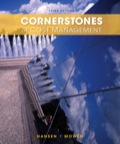
Bill Fremont, division controller and CMA, was upset by a recent memo he received from the divisional manager, Steve Preston. Bill was scheduled to present the division’s financial performance at headquarters in one week. In the memo, Steve had given Bill some instructions for this upcoming report. In particular, Bill had been told to emphasize the significant improvement in the division’s profits over last year. Bill, however, didn’t believe that there was any real underlying improvement in the division’s performance and was reluctant to say otherwise. He knew that the increase in profits was because of Steve’s conscious decision to produce more inventory.
In an earlier meeting, Steve had convinced his plant managers to produce more than they knew they could sell. He argued that by deferring some of this period’s fixed costs, reported profits would jump. He pointed out two significant benefits. First, by increasing profits, the division could exceed the minimum level needed so that all the managers would qualify for the annual bonus. Second, by meeting the budgeted profit level, the division would be better able to compete for much-needed capital. Bill objected but had been overruled. The most persuasive counterargument was that the increase in inventory could be liquidated in the coming year as the economy improved. Bill, however, considered this event unlikely. From past experience, he knew that it would take at least two years of improved market demand before the productive capacity of the division was exceeded.
Required:
- 1. Discuss the behavior of Steve Preston, the divisional manager. Was the decision to produce for inventory an ethical one?
- 2. What should Bill Fremont do? Should he comply with the directive to emphasize the increase in profits? If not, what options does he have?
- 3. Chapter 1 listed ethical standards for
management accountants. Identify any standards that apply in this situation.
Want to see the full answer?
Check out a sample textbook solution
Chapter 18 Solutions
EBK CORNERSTONES OF COST MANAGEMENT
- The Tin company uses the straight-line method to depreciate its equipment. On May 1, 2018, the company purchased some equipment for $200,000. The equipment is estimated to have a useful life of ten years and a salvage value of $20,000. How much depreciation expense should Tin record for the equipment in the adjusting entry on December 31, 2018? Answerarrow_forwardFinancial Accounting Question please answerarrow_forwardPlease provide answerarrow_forward
- Explore the concept of accounting flexibility and its impact on the reliability and usefulness of financial information. While adaptability in accounting methods can allow organizations to better reflect their unique circumstances, it may also introduce the risk of selective application or manipulation. Discuss the appropriate balance between standardization and customization in accounting practices, and the safeguards that can be implemented to preserve the integrity of financial reporting.arrow_forwardColton Inc. is a merchandising company. Last month, the company's cost of goods sold was $85,600. The company's beginning merchandise inventory was $18,200, and its ending merchandise inventory was $30,500. What was the total amount of the company's merchandise purchases for the month? Answer this questionarrow_forwardCash receipts from accounts receivable collection in June?arrow_forward
 Cornerstones of Cost Management (Cornerstones Ser...AccountingISBN:9781305970663Author:Don R. Hansen, Maryanne M. MowenPublisher:Cengage Learning
Cornerstones of Cost Management (Cornerstones Ser...AccountingISBN:9781305970663Author:Don R. Hansen, Maryanne M. MowenPublisher:Cengage Learning Managerial Accounting: The Cornerstone of Busines...AccountingISBN:9781337115773Author:Maryanne M. Mowen, Don R. Hansen, Dan L. HeitgerPublisher:Cengage Learning
Managerial Accounting: The Cornerstone of Busines...AccountingISBN:9781337115773Author:Maryanne M. Mowen, Don R. Hansen, Dan L. HeitgerPublisher:Cengage Learning

